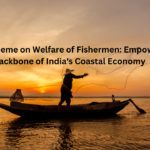The PM Matsya Sampada Yojana (PMMSY) is a flagship scheme launched by the Government of India under the leadership of Prime Minister Narendra Modi. The scheme aims to bring about a Blue Revolution through sustainable and responsible development of the fisheries sector in India. Launched in September 2020, PMMSY is a part of the Atmanirbhar Bharat (Self-Reliant India) initiative and aims to double fish production and export earnings while providing employment opportunities and improving the socio-economic conditions of fishers and fish farmers.
Watch Video
Objectives of PM Matsya Sampada Yojana
The PM Matsya Sampada Yojana (PMMSY) is an ambitious scheme initiated by the Indian government to revolutionize the fisheries sector. Here are the key objectives of the scheme:
Enhancing Fish Production and Productivity
The primary objective of PMMSY is to significantly increase fish production and productivity. The target is to boost fish production from 13.75 million metric tonnes in 2018-19 to 22 million metric tonnes by 2024-25. This goal aims to meet the growing domestic demand for fish and fish products and to support nutritional security.
Doubling Export Earnings
Another critical goal of the scheme is to enhance the export earnings from the fisheries sector. By improving fish production and ensuring high quality standards, PMMSY aims to double the income from fish exports, targeting INR 1 lakh crore by 2024-25. This initiative is expected to position India as a leading exporter in the global fish market.
Employment Generation
PMMSY is designed to generate substantial employment opportunities. The scheme aims to create about 55 lakh (5.5 million) direct and indirect jobs in the fisheries sector and related activities. This includes employment in aquaculture, fish processing, marketing, and other allied services, thereby contributing to the overall economic development of the country.
Enhancing Aquaculture and Fisheries Infrastructure
A significant focus of PMMSY is on building robust infrastructure to support the fisheries sector. This includes the development of cold chains, fish processing units, and marketing facilities. The scheme also aims to improve post-harvest management infrastructure to minimize wastage and enhance the value chain.
Sustainable and Responsible Development
The scheme promotes sustainable and responsible fishing practices. It emphasizes the conservation of marine resources and the responsible management of fisheries. PMMSY supports initiatives that ensure the long-term sustainability of the fisheries sector, protecting the environment while boosting economic growth.
Key Components of PMMSY
Key Components of PMMSY
Central Sector Scheme (CS)
The Central Sector Scheme is entirely funded by the Central Government. This component focuses on the development of critical infrastructure to support the fisheries sector. Key activities under this scheme include:
- Fishing Harbors and Fish Landing Centers: Establishing and upgrading fishing harbors and landing centers to facilitate efficient and safe handling of fish catches.
- Integrated Modern Fish Markets: Developing modern fish markets with facilities like cold storage, processing units, and hygiene management to enhance the fish marketing infrastructure.
Centrally Sponsored Scheme (CSS)
The Centrally Sponsored Scheme is implemented in collaboration with state governments, with the funding shared between the Central Government and the state governments. This component covers a wide range of activities aimed at boosting fish production and aquaculture development. Key activities under this scheme include:
Establishing Fish Farms: Developing new fish farms and upgrading existing ones to increase fish production and productivity.
Fish Seed Production: Promoting the production of high-quality fish seeds to ensure the availability of good stock for aquaculture.
Development of Hatcheries: Establishing and upgrading hatcheries for breeding and raising fish larvae, ensuring a steady supply of fish for aquaculture.
Fish Feed Plants: Setting up and modernizing fish feed plants to provide nutritious and cost-effective feed for fish farming.
Major Initiatives under PMMSY
Development of Inland Fisheries and Aquaculture
PMMSY promotes the growth of inland fisheries and aquaculture through several key initiatives:
- Constructing New Ponds and Tanks: Creating new water bodies to increase fish farming areas and boost fish production.
- Establishing Hatcheries: Setting up hatcheries to ensure a steady supply of high-quality fish seeds for aquaculture.
- Promoting Cage Culture in Reservoirs: Encouraging the use of cage culture in reservoirs to enhance fish production and optimize the use of water resources.
Marine Fisheries and Post-Harvest Infrastructure
To modernize marine fisheries and improve post-harvest processes, PMMSY focuses on:
- Support for Deep-Sea Fishing Vessels: Providing financial and technical support for the acquisition and operation of deep-sea fishing vessels.
- Fish Landing Centers: Developing and upgrading fish landing centers to improve the efficiency and safety of fish handling and storage.
- Post-Harvest Infrastructure: Establishing and upgrading ice plants, cold storage facilities, and other post-harvest infrastructure to reduce wastage and maintain the quality of fish products.
Aquatic Health Management
Ensuring the health of aquatic animals is essential for sustainable fisheries. PMMSY includes initiatives such as:
- Disease Monitoring: Implementing systems for regular monitoring and management of aquatic animal diseases.
- Establishing Diagnostic Laboratories: Setting up diagnostic labs to detect and address health issues in aquaculture.
- Promoting Biosecurity Measures: Encouraging the adoption of biosecurity practices to prevent the spread of diseases and ensure healthy aquaculture environments.
Capacity Building and Training
The scheme emphasizes the importance of capacity building and skill development for stakeholders in the fisheries sector:
- Training Programs: Organizing training programs to enhance the skills and knowledge of fishers, fish farmers, and other stakeholders.
- Workshops and Exposure Visits: Conducting workshops and exposure visits to share best practices and innovative techniques in fisheries and aquaculture.
Innovation and Research
PMMSY fosters innovation and research in the fisheries sector to drive growth and sustainability:
- Supporting Research Projects: Funding research projects that address key challenges and opportunities in the fisheries sector.
- Developing New Technologies: Promoting the development and adoption of new technologies to improve efficiency and productivity.
- Advanced Equipment and Practices: Encouraging the use of advanced equipment and modern practices to enhance fish farming and processing.
Implementation and Monitoring
Multi-Tiered Implementation Structure
PM Matsya Sampada Yojana (PMMSY) is implemented through a comprehensive, multi-tiered structure involving various levels of government and stakeholders. This structure ensures coordinated and efficient execution of the scheme’s initiatives.
1. Central Government
- Nodal Agency: The Department of Fisheries, under the Ministry of Fisheries, Animal Husbandry, and Dairying, serves as the nodal agency for the overall implementation and coordination of PMMSY.
- Policy Formulation: The Central Government is responsible for formulating policies, guidelines, and frameworks necessary for the scheme’s implementation.
- Funding and Resource Allocation: The Central Government allocates funds and resources for the scheme and oversees their distribution to states and other entities.
2. State Governments and Union Territories
- State-Level Implementation: State Governments and Union Territories are responsible for implementing PMMSY initiatives at the state and local levels. They adapt the central guidelines to suit local conditions and needs.
- Coordination and Support: State-level agencies coordinate with the Central Government and other stakeholders to ensure smooth execution of the scheme.
- Resource Utilization: States manage and utilize the funds and resources allocated by the Central Government, ensuring their effective use in line with the scheme’s objectives.
3. Other Stakeholders
- Local Bodies and Community Organizations: Local governing bodies, cooperatives, and community organizations play a crucial role in implementing PMMSY initiatives on the ground, ensuring community participation and support.
- Private Sector and NGOs: The private sector and non-governmental organizations (NGOs) collaborate in various capacities, providing technical expertise, infrastructure, and support services.
Monitoring and Evaluation Mechanisms
To ensure the effective implementation and timely achievement of PMMSY’s objectives, robust monitoring and evaluation mechanisms are in place:
1. Regular Monitoring
- Progress Reports: Periodic progress reports are submitted by state governments and other implementing agencies to the Central Government. These reports detail the status of various initiatives, fund utilization, and challenges faced.
- Field Visits and Inspections: Regular field visits and inspections are conducted by officials at various levels to assess on-ground implementation and address any issues promptly.
2. Evaluation and Assessment
- Third-Party Evaluations: Independent third-party evaluations are conducted to provide an unbiased assessment of the scheme’s effectiveness, impact, and areas for improvement.
- Impact Assessments: Comprehensive impact assessments are carried out to measure the long-term benefits of the scheme on fish production, employment generation, and the overall economy.
3. Feedback Mechanisms
Grievance Redressal: A grievance redressal mechanism is established to address any concerns or complaints from stakeholders promptly and effectively.
Stakeholder Consultations: Regular consultations with stakeholders, including fishers, fish farmers, industry experts, and community representatives, help gather feedback and suggestions for improving the scheme.
Impact and Benefits
Multi-Tiered Implementation Structure
PM Matsya Sampada Yojana (PMMSY) is implemented through a comprehensive, multi-tiered structure involving various levels of government and stakeholders. This structure ensures coordinated and efficient execution of the scheme’s initiatives.
1. Central Government
- Nodal Agency: The Department of Fisheries, under the Ministry of Fisheries, Animal Husbandry, and Dairying, serves as the nodal agency for the overall implementation and coordination of PMMSY.
- Policy Formulation: The Central Government is responsible for formulating policies, guidelines, and frameworks necessary for the scheme’s implementation.
- Funding and Resource Allocation: The Central Government allocates funds and resources for the scheme and oversees their distribution to states and other entities.
2. State Governments and Union Territories
- State-Level Implementation: State Governments and Union Territories are responsible for implementing PMMSY initiatives at the state and local levels. They adapt the central guidelines to suit local conditions and needs.
- Coordination and Support: State-level agencies coordinate with the Central Government and other stakeholders to ensure smooth execution of the scheme.
- Resource Utilization: States manage and utilize the funds and resources allocated by the Central Government, ensuring their effective use in line with the scheme’s objectives.
3. Other Stakeholders
- Local Bodies and Community Organizations: Local governing bodies, cooperatives, and community organizations play a crucial role in implementing PMMSY initiatives on the ground, ensuring community participation and support.
- Private Sector and NGOs: The private sector and non-governmental organizations (NGOs) collaborate in various capacities, providing technical expertise, infrastructure, and support services.
Monitoring and Evaluation Mechanisms
To ensure the effective implementation and timely achievement of PMMSY’s objectives, robust monitoring and evaluation mechanisms are in place:
1. Regular Monitoring
- Progress Reports: Periodic progress reports are submitted by state governments and other implementing agencies to the Central Government. These reports detail the status of various initiatives, fund utilization, and challenges faced.
- Field Visits and Inspections: Regular field visits and inspections are conducted by officials at various levels to assess on-ground implementation and address any issues promptly.
2. Evaluation and Assessment
- Third-Party Evaluations: Independent third-party evaluations are conducted to provide an unbiased assessment of the scheme’s effectiveness, impact, and areas for improvement.
- Impact Assessments: Comprehensive impact assessments are carried out to measure the long-term benefits of the scheme on fish production, employment generation, and the overall economy.
3. Feedback Mechanisms
Grievance Redressal: A grievance redressal mechanism is established to address any concerns or complaints from stakeholders promptly and effectively.
Stakeholder Consultations: Regular consultations with stakeholders, including fishers, fish farmers, industry experts, and community representatives, help gather feedback and suggestions for improving the scheme.
Top 10 Key Points of PM Matsya Sampada Yojana
- Enhancing Fish Production:
- Aim: Increase fish production from 13.75 million metric tonnes (2018-19) to 22 million metric tonnes by 2024-25.
- Doubling Export Earnings:
- Target: Achieve fish export earnings of INR 1 lakh crore by 2024-25.
- Employment Generation:
- Goal: Create around 55 lakh direct and indirect employment opportunities in the fisheries sector.
- Infrastructure Development:
- Focus: Establish modern fishing harbors, fish landing centers, and integrated fish markets with robust post-harvest infrastructure like cold chains and processing units.
- Sustainable and Responsible Fishing:
- Initiative: Promote sustainable fishing practices, conserve marine resources, and ensure responsible management of fisheries.
- Central Sector Scheme (CSS):
- Funding: 100% funded by the Central Government for infrastructure development projects.
- Centrally Sponsored Scheme (CSS):
- Collaboration: Joint implementation with state governments, sharing funding between the Centre and states for activities like fish seed production and hatcheries development.
- Inland Fisheries and Aquaculture Development:
- Activities: Construct new ponds and tanks, establish hatcheries, and promote cage culture in reservoirs to boost inland fisheries and aquaculture.
- Marine Fisheries Modernization:
- Support: Provide deep-sea fishing vessels, establish fish landing centers, and develop post-harvest infrastructure such as ice plants and cold storage facilities.
- Capacity Building and Innovation:
- Programs: Conduct training programs, workshops, and exposure visits for skill development. Support research projects, new technologies, and advanced equipment in fisheries.
Watch Video
Conclusion
PM Matsya Sampada Yojana is a landmark initiative that underscores the Government of India’s commitment to the holistic development of the fisheries sector. By fostering sustainable practices, enhancing infrastructure, and promoting innovation, the scheme aims to achieve a Blue Revolution in India, ensuring food security, economic growth, and improved livelihoods for millions of people dependent on fisheries.
PM Matsya Sampada Yojana: Top 20 FAQs with Answers
1. What is the PM Matsya Sampada Yojana (PMMSY)?
- The PM Matsya Sampada Yojana (PMMSY) is a flagship scheme launched by the Government of India to promote the sustainable development of the fisheries sector and bring about a Blue Revolution.
2. When was PMMSY launched?
- PMMSY was launched in September 2020 as part of the Atmanirbhar Bharat (Self-Reliant India) initiative.
3. What are the main objectives of PMMSY?
- The main objectives are to enhance fish production and productivity, double export earnings, generate employment, develop fisheries infrastructure, and promote sustainable and responsible fishing practices.
4. How does PMMSY aim to increase fish production?
- The scheme aims to increase fish production from 13.75 million metric tonnes (2018-19) to 22 million metric tonnes by 2024-25 through various development initiatives.
5. What is the target for fish export earnings under PMMSY?
- The target is to double fish export earnings to reach INR 1 lakh crore by 2024-25.
6. How many employment opportunities does PMMSY aim to create?
- PMMSY aims to generate around 55 lakh direct and indirect employment opportunities in the fisheries sector.
7. What types of infrastructure developments are supported under PMMSY?
- The scheme supports the development of fishing harbors, fish landing centers, integrated fish markets, cold chains, and fish processing units.
8. What is the difference between the Central Sector Scheme (CSS) and Centrally Sponsored Scheme (CSS) under PMMSY?
- The Central Sector Scheme (CSS) is 100% funded by the Central Government and focuses on infrastructure development. The Centrally Sponsored Scheme (CSS) is jointly funded by the Centre and state governments, covering activities like fish seed production and hatchery development.
9. How does PMMSY promote sustainable fishing practices?
- PMMSY promotes sustainable fishing practices through conservation measures, responsible resource management, and the adoption of eco-friendly technologies.
10. What initiatives are included in the development of inland fisheries and aquaculture? – Initiatives include constructing new ponds and tanks, establishing hatcheries, and promoting cage culture in reservoirs.
11. What support is provided for marine fisheries under PMMSY? – Support includes providing deep-sea fishing vessels, developing fish landing centers, and creating post-harvest infrastructure like ice plants and cold storage facilities.
12. How does PMMSY address aquatic health management? – The scheme includes disease monitoring, establishing diagnostic laboratories, and promoting biosecurity measures to ensure the health of aquatic animals.
13. What capacity-building initiatives are included in PMMSY? – The scheme focuses on training programs, workshops, and exposure visits to enhance the skills of fishers, fish farmers, and other stakeholders.
14. How does PMMSY encourage innovation and research? – PMMSY supports research projects, the development of new technologies, and the use of advanced equipment and practices in the fisheries sector.
15. Who is responsible for implementing PMMSY? – The Department of Fisheries, Ministry of Fisheries, Animal Husbandry, and Dairying is the nodal agency for the scheme’s implementation, working in collaboration with state governments, Union Territories, and other stakeholders.
16. How is the progress of PMMSY monitored? – Regular monitoring and evaluation mechanisms are in place to ensure effective implementation and timely achievement of the scheme’s objectives.
17. What are the expected socio-economic benefits of PMMSY? – PMMSY is expected to boost fish production, enhance the income of fishers and fish farmers, generate employment opportunities, and contribute significantly to the country’s economy.
18. How can fishers and fish farmers benefit from PMMSY? – They can benefit from increased production capacities, better infrastructure, skill development programs, and improved market access, leading to higher incomes and better livelihoods.
19. Is there any financial assistance available under PMMSY? – Yes, PMMSY provides financial assistance for various activities, including infrastructure development, fish seed production, aquaculture development, and capacity building.
20. Where can I find more information about PMMSY? – More information can be found on the official website of the Department of Fisheries, Ministry of Fisheries, Animal Husbandry, and Dairying, Government of India.






